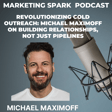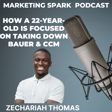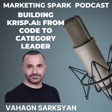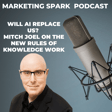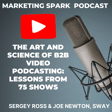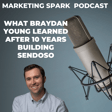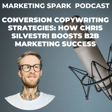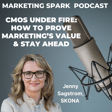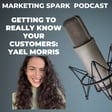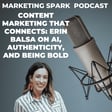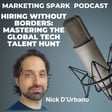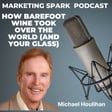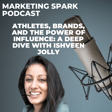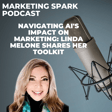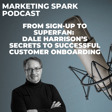Become a Creator today!Start creating today - Share your story with the world!
Start for free
00:00:00
00:00:01

Onboarding That Sticks: Ramli John’s Guide to Turning New Users into Lifelong Advocates
In this episode of Marketing Spark, Mark Evans talks with Ramli John, founder of Delight Path and author of Product-Led Onboarding, about the secrets to effective onboarding and customer retention.
They explore why retention efforts often begin too late, the three pillars of customer engagement, and the pivotal role onboarding plays in fostering long-term loyalty.
Ramli shares actionable strategies for developing a retention-focused onboarding process and explains the "hyper-personalization" potential of AI in creating tailored customer journeys.
Tune in to learn how to keep your customers excited, engaged, and loyal beyond the initial sale.
Transcript
Podcast Introduction
00:00:08
Speaker
Welcome to Marketing Spark, where we have conversations with CEOs, entrepreneurs, and marketing leaders about the strategies driving today's most successful businesses. I'm your host, Mark Evans.
Guest Introduction: Ramly John
00:00:19
Speaker
In today's episode, I'm speaking with Ramly John, founder of DelightPath, an expert in customer onboarding and retention, and author of the best-selling book, Product-Lead onboarding.
Strategies for Customer Excitement and Loyalty
00:00:30
Speaker
Today, we'll be diving into one of the most critical elements for business success, keeping customers not just satisfied, but excited and as important, fiercely loyal. We'll explore actionable strategies for building relationships that last because after all,
00:00:46
Speaker
It's not just about making sales, but keeping your customers by engaging, educating, and continuing to show them how to get value from your product.
New Book: Eureka and Retention Strategies
00:00:54
Speaker
Welcome to Marketing Spark, Ramley. I'm excited to be here. Mark, I appreciate you for the in invitation. As someone who has written three books, I was intrigued by the recent announcement that you've got an upcoming book project. Can you tell us more about how it expands on the ideas from product-leg onboarding and how it focuses on retention?
00:01:16
Speaker
don The first book I wrote, Product-led onboarding, the name suggests it's really mainly
The Role of Human Interaction in B2B Growth
00:01:22
Speaker
product-led. It's about building a self-serve experience. The challenge with that is often that as B2B companies scale, it's not enough to have a self-serve or product-led approach. A lot of companies that we think are product-led, like Slack,
00:01:37
Speaker
and Zapier, they have a person, even AppQs, where I used to work at, which has pioneered and also was ah a leader in the product-led space, has a human onboarding approach to it. So Eureka, the new book, will be covering more of two other aspects that I didn't cover as
Exploring Retention Approaches in Eureka
00:01:55
Speaker
much in the book. First is a one-to-one. When does a human when this a customer onboarding or customer success team, or even the sales team,
00:02:02
Speaker
When is it the right time to approach and really help a customer? What you said earlier, get them excited and become a fierce, loyal fan of your product. But the other approach is one-to-many. So things like customer education and courses and things like that. All of this, there's three things, this one-to-one, one-to-many, as well as self-serve approach. How do they work together to to build that habit-forming experience that really gets customers excited about your product and stick for a long time?
Advice on Writing Books
00:02:32
Speaker
Before we hit the record button, we were talking about book writing and how in some ways it's getting that tattoo. You forget that it's quite painful and then you think about it and go, hey, this tattoo looks pretty good. Maybe I'll get another one. But you forget about the fact that it took months and months to write the book. I know a lot of people are interested in writing a book. It's a daunting proposition. What are the lessons that you can offer people writing a book for the first time? As important, what are some of the things that you're going to change now that you've got experience in writing book one? what What lessons will you or best practices will you bring to Eureka?
Early Readers Club for Feedback and Promotion
00:03:13
Speaker
That's something that I've just been thinking ah about as well. What will I change from the first one? For people interested in writing a book, the first advice I have
00:03:22
Speaker
is in terms of the topic, when you say your name, Ramly John, what do you want to be known as an expert for? Ramly John, expert in X or whatever your name is, what are you expert in Y or whatever that is. Once you write a book and you know this, you've written three books, people attach that topic to your name now and maybe forever more. As long as there's books around, I think that's the first thing that you help out, which topic is it too deep or too thin. The other thing that I've seen work well is teach the concept first before you you start writing. So ah that's what I did for one previous book we had that was work when I was working with product lead at West Bush. We taught a product lead onboarding cohort course.
00:04:10
Speaker
Now I'm doing the same with this book. I have a court course launching with Maven starting next week where I'm going to teach some of the concepts about this. The reason why it's so valuable is first of all, you get instant feedback. You're telling your frameworks, your stories. therere there are People are responding. You're seeing zoom over Zoom or in person.
00:04:30
Speaker
how people are reacting to it. The second thing is that you're getting a way to figure out the structure because building a course is providing you structure and it's also giving you a deadline. It's, I gotta teach it next week. You don't have a choice versus writing your book could be all my years. I have some time I can relax.
00:04:49
Speaker
and That's what worked well for the first time that I'm doing this time as well. Things that I'm changing, I wish the first time I announced it sooner. So that's what I did eight months before it launches. I've already announced it. But second thing is I'm creating an early readers club, like earlier on, like a private community for people who are interested about the book. I think
Books as Tools for Thought Leadership
00:05:10
Speaker
that's great for providing not just feedback about the book, but when the book launches.
00:05:15
Speaker
that people have, ah you have a launch crew, people who can help promote it. They have some vested interests because they provide their feedback. It's something that I didn't do the first time around. It was over email, people applied, but I've seen.
00:05:28
Speaker
really great product books come out where that's the approach that they did. And they really helped with just a book about OKRs. I'm trying to figure out who wrote it, but that's what they did when they wrote the book and they had the two authors got some great feedback from the book itself. So that's one thing I'm trying to do this time around that I didn't do the first time.
00:05:51
Speaker
If someone is thinking about writing a book, one of the things is the Nike approach, just do it. It is a lot of work, but it's satisfying. I would say yeah that it's a labor of love. One of the things that I would be clear about is what you're going to get from writing a book. In many cases, a book is not going to generate revenue. You're never going to get royalties from because you'll never sell enough copies. So you can stop thinking about a book as a revenue tool. You might get lucky and change things, but it's great for other things. Thought leadership,
00:06:24
Speaker
Give you credibility if you're a consultant and you're looking to attract clients or you're trying to get a new job or if you want speaking opportunities. A book is a great vehicle to have. One of the other things you should think about is what are your goals? What does success look like? like If you've got a niche, then you should probably scratch it.
Focus on Retention Over Acquisition
00:06:40
Speaker
Let's turn over our sights to the topic of the day, which is retention. In some cases,
00:06:46
Speaker
retention is as complex or more complex than onboarding. A couple of questions, what do you believe are the key elements of a successful retention strategy? And as important, what are some of the common mistakes that companies make in the retention efforts? We can start about the retention efforts. I'm surprised if any company has any retention efforts until there's a problem. That's what we face at AppQs where If he often companies, they approach retention problems, not as problems, but oh no, we need to acquire more customers. Let's go acquire more customers. That's great when the economy is doing well, you have funding, you're able to generate leads quickly. It doesn't seem like a problem until everything slows down and it's all about, oh dang, we're losing customers. We need to keep as many as that we have as quickly as possible. That's a challenge where if you're not thinking about retention,
00:07:39
Speaker
From the get-go, then, especially in recurring products, recurring revenue products like SaaS or even membership, that's ah yeah even e-commerce world, it's much cheaper to get an existing customer to come back and make a purchase than it is to try to convince a cold buyer who's never heard of you to purchase again and thinking about how and where and when.
00:08:03
Speaker
you you to get them to come back is super, super important. That's the problem I think a lot of companies have in terms of retention is it's not a priority until it's an emergency. That's a great tagline that a lot of companies should embrace. One thing that I do want to ask you about retention is that the strategy, the playbook for a lot of companies when it comes to retention is we're going to issue a monthly or quarterly newsletter and it's mostly going to be about us and our product and the conferences or the awards that we won. That's it. That's the end of the retention strike was to start and the end of their retention strategy. What is a ideal retention strategy look like? If you had a playbook, I'm sure you have a playbook for this type of thing.
00:08:52
Speaker
What kind of levers are you pulling? As I said off the top, you're engaging your customers, you're educating them and showing them that yes, you made the right decision yeah and we're going to reinforce and validate that decision as you continue to do business as well with us. What does that secret or that recipe look like from your attention
Supporting Customer Growth Beyond the Product
00:09:12
Speaker
standpoint?
00:09:12
Speaker
There's a few ways to approach retention. I think the first is you mentioned newsletter. That's great. But we were talking about books earlier. What is the why behind that? Let me give you a great example of why and how you fit into their retention strategy. I got a chance to talk to the former head of customer marketing or community at HubSpot.
00:09:35
Speaker
But one of the things you said was your strategy for retention was let's just not help our customers level up how they do work. But how can we help them become better versions of themselves? Not just at the current job.
00:09:50
Speaker
But in their career, they started offering, yeah as we know HubSpot Academy, pioneered the Academy space, but started producing courses that is all around leveling up, becoming a better marketer, a social marketer, and helping them get the promotion sometimes, where like HubSpot was not even in the conversation. They're teaching courses about that's such a great emotional connection.
00:10:16
Speaker
Where there's people behind your customers, they're often in B2B, we're just serving businesses. But there are real people who have jobs, they're going through layoffs and they're looking to get make more money and they have kids. How do you?
00:10:34
Speaker
level those specific people up because when you're thinking about retention and loyalty, when they go to another company, they love what you did so much that I don't know what CRM we have, but we got to bring on HubSpot because they're great. They helped me get a job and level up. That's really what it's all about. I would ask if you're thinking about content, newsletter,
00:10:55
Speaker
Who are you leveling up? How are you leveling them up? How do you build them up in ways that sometimes goes beyond your product and you can really help them with that what they're doing in their jobs specifically. That's a great point. It's easy to forget that companies don't buy products. People buy products. Yeah. <unk>s It's a people to people relationship. When you're trying to retain somebody, it's a very personal relationship that you're building. A lot of it has to do with emotional connections and recognizing being empathetic and that your customers have their own aspirations, their own goals. yeah The one thing that you mentioned that stood out and and I was talking to a client recently was that people do change jobs.
00:11:41
Speaker
and that if they have a good relationship and with your company and they trust you and they like you and they feel that you played a role in helping them advance their careers, they will take you to their next job.
00:11:55
Speaker
It's easy to call it referrals, but really it's retention it's a retention dividend for lack of a better term. That's probably is something that's not part of the retention mix because we just overlook people and we're just focused on serving customers. I'm glad you mentioned that. I wanted to see if we could connect onboarding with customer
Impact of Onboarding on Retention
00:12:16
Speaker
retention. I'm sure you can because you're the expert in both of these areas.
00:12:19
Speaker
but What role does onboarding play in retention? Where do companies typically miss the mark when they're trying to align? but Think about it like onboarding is the early stages of ah newborn. I have a two year old kid and my my wife is an educator and she always says in her study as an educator, the very first few months and years of a child sets them up for how they're going to learn their character and their ability and the desire to learn. That's the same thing here where the first few minutes and even the first few days of a customer is really setting up the future of how they will have a relationship with your company or not. It's really about building that foundation for them to really be excited about what they're about to learn and what they're about to do. One of the ah mistakes often is that first few minutes of somebody signing up or buying a product is an exciting moment because
00:13:15
Speaker
They just, they ah believe in a promise that your product can do something. The question is, will you deliver? What often happens if they don't see value right away is that they start wondering, did I make the right choice? They start getting buyers remorse. I've purchased something before. I don't know if I want this. Amazon makes it easy for you to return stuff, which is why I love often buying stuff from Amazon because, oh man, I don't know if I wanted this. I just thought it was cool. I get it and I was, oh, I'm just going to return it. That's not what you want. How do you make people feel comfortable? Your customers feel comfortable at that point so that they feel good about what they're about to do with your product or not.
00:13:56
Speaker
And really like how do you amplify that excitement that early excitement. How do you reduce any kind of fears that they might have and how do you show them value really quickly. That is what all um great onboarding handles and really get some excited and set them up for the foundation of retention or talking about conceptually that sounds great.
00:14:18
Speaker
the idea that you deliver value out of the gate. A lot of people will recognize that when they sign up for a SaaS service is you'll get the obligatory welcome message and you might get a follow-up message with your login information.
00:14:32
Speaker
But that's about it. There's nothing that helps you get into the product to immediately get value from the product. In your experience, what should a company do after someone clicks on purchase and that welcome email has been
Guiding Customers to Value Quickly
00:14:49
Speaker
fired off? What should happen the next hour, the next day, the next week, the next month?
00:14:56
Speaker
Within the first seven minutes, this is something that studies have shown you got seven minutes or less to get as soon as somebody sign up. This is something that I've heard companies like Canva and other companies where let's nail the first seven minutes. What needs to happen in the first seven minutes, that sounds like it's not a lot of time. it It isn't. I think first, understand what is success for this person who just bought this.
00:15:20
Speaker
Why did they buy it? And if you're doing this one-to-one, that's great. But if you're doing this at scale, how do you do that? Sometimes ah during the signup or setup process, just asking a question like, and what brought you, what is, just asking straight up, why did you sign up? What is your main goal for signing up?
00:15:38
Speaker
and then give them three options. Simple example with AppQs, AppQs is an easy way to onboard users, but that's not their only use case. So when I was working there, one of the questions that we added was, why did you sign up? First, I'm trying to onboard my new users. Second, I'm trying to make announcements to my customers to let them know about new product releases. And third, I'm trying to get feedback about my new features that I'm trying to release them.
00:16:03
Speaker
Asking that straight it up now helps guide you to tell you, I need to show this person and this customer exactly what they told me that they wanted. So removing any kind of flows, any kind of any kind of paths or any kind of distractions that could block them from seeing and experiencing that is the key crucial moment right there. So I think if I had to break it down to steps first, find out why your customer bought your product second,
00:16:33
Speaker
guide them there How do you get guide them there and remove any kind of distractions? And then third, I think I would reaffirm that and ask them to do that action multiple times. That's what people call the habit moment. How do you yeah build a habit around something is when there's a little bit of repetition. So how do you encourage them with email and communication to continue to use that value? because There's studies that show it takes X number of days for you to do something before it becomes habit. I think it's 30 days. I'm not entirely sure if if I recall, but that's the kind of really what you want to be doing during the onboarding. It's not just to show them and the value, but how to build habits around that particular value. When I look at the many onboarding emails I've got and over the years, hundreds, if not thousands, the ones that stand out to me
00:17:26
Speaker
Basically say, hey, Mark, welcome to our service. Here's three things that you should do right now. Do this and do this. It's prescriptive. It guides me. It gives a roadmap in terms of how I can get myself into the product. Three easy use cases or free three user-friendly ways that I can Get into a product guidance that makes my world easier eliminates friction between me and the product if you can do that then you're off to the races i i did want to ask you. ah About how companies can build a seamless transition from onboarding to retention i've signed up for the service.
00:18:05
Speaker
You started to onboard me in a very best practice way when does it flip over to retention at what point is it during the seven minutes that you talked about or is it during the first week but at what moment does that arrow go from onboarding to retention.
00:18:21
Speaker
That's the hard part about activation retention, onboarding and retention. It's just a huge overlap between the two of them. You can argue that the first seven minutes is like early retention. Short-term retention is between the first few days that somebody signs up. How do you keep them engaged during those those few days? Something I've heard is long-term retention is how do you continue get them to continue using the product?
00:18:45
Speaker
90 days and beyond. Often what happens with Teams is when you're thinking about breaking it up into onboarding versus activation versus ah retention, it's figuring out when it crosses over to the next level. With AppQ, what we did was that the onboarding team held on to the customer for the first 90 days. It was just arbitrary because 90 days sounds good, three months. You can make that day mark a specific day and after the 90 days, it gets handed off to the customer success team as more of a retention plan, getting them engagement, engaged throughout that. And that's something that the team needs to decide on and to discuss of like how at what point it does cross over to another one. I'd like to break it up into three stages. How do you retain the customer the first seven minutes? Because this is a huge drop off usually for product-led companies where somebody signs up, seven minutes, they never come back.
00:19:42
Speaker
How do you get them engaged there? The next is how do you get them engaged in the next seven days? That's where communication and email kicks in. That's seven day retention. The next is how do you get them engaged in the next 90 days? That's all about 90 day retention. How do you get them continue using the product? Maybe start using advanced use cases and things and beyond would be long term retention. How do you get them to stick around for a long time? That's how we think about breaking it up. That's great insight.
00:20:09
Speaker
The big hairy beast, the 800 pound gorilla in the room when it comes to retention is
Understanding Churn in Business Strategy
00:20:15
Speaker
churn. Churn is a reality. No matter how good your product is, no matter how well you treat your customers, they leave for a variety of reasons. Sometimes they leave because they have no use for the product anymore. Sometimes it's a shiny new object.
00:20:30
Speaker
Maybe it's one of those fancy AI tools that captures their attention, but they do stop doing business with the company. A couple of questions. How should companies approach customer churn? And is there a point where it's better to let a customer churn rather than focusing on retention?
00:20:47
Speaker
That's a really insightful question. There is times when, especially as companies evolve and they're expanding into more different markets or different enterprise maybe larger customers, in that case, maybe the product is not particularly useful for them anymore. an example A classic example is at a previous company I was working at, we were using intercom for some time to both in onboarding emails, but at that point, i it wasn't that app case. We were using it for the product tours as well. And at some point, they increased their price to the point where it's obviously we're targeting enterprise. In that case, we turned out, and it's probably what they expected because they're hoping that enterprise deals would make up for the smaller businesses that was using the product. In that case, if it's strategic,
00:21:37
Speaker
Then it might make sense, especially and even a shift in your customers, in your market might might require some churn as well. That's something that needs to be considered where churn is it's often. own It is welcome, I think, in in some ways, where in the case we're moving to another place, to another market as well. And it's also being very clear about who your target audience is, as both of us being consultants. We have we we know who are our target customer ah target companies are. And when there's a company that's maybe a mobile, let's say a mobile app approached me right now. I don't have any experience in mobile
00:22:17
Speaker
Right. And they maybe we sign up for a few months of advising. It would not be a fit. At some point I would be this is not my bread. This is not my expertise. If it's not in your the company's zone of expertise, then in that case, then it totally makes sense for it to shift over to another place. Related to churn from a quantitative point of view.
00:22:38
Speaker
What are the key metrics for retention? I'm also curious about the qualitative side of things, the underutilized retention metrics that a company should be tracking and how they're part of the overall mix.
Balancing Qualitative and Quantitative Metrics
00:22:54
Speaker
Can you talk to qualitative and quantitative Churn metrics. Let's talk about qualitative. I think that's ah very helpful as well. Figuring out what are the reasons why. I think that's why often churn interviews are quite helpful. What change in their business, maybe they outgrew you. In that case, that is an expected churn. When there's unexpected churn, that's when churn surveys I've seen could be very helpful.
00:23:22
Speaker
In terms of quantitative, obviously you want to be looking at churn rate. How many people who in that cohort ah stop becoming a customer? There's also something called net recurring retention. Often when we talk about churn, it's not necessarily customers itself, but it might be the revenue dollars. You might have a few customers fall off.
00:23:44
Speaker
But because bigger companies have joined in, you have a net positive net recurring retention in terms of your in terms of your a dollar that you have. That's quite a good thing where maybe your current customers in that space expanded to higher plans. Is that something that i you want to take a look at?
00:24:02
Speaker
Obviously, you also want to be looking at engagement rates. Maybe there are certain red flags. One of the biggest red flag is you have a customer and they've stopped logging in or stop using your product. In that case, that's a really big problem that you need to send in people. Are they pausing it? Are they doing something there? That should be something that should be red flag. Some tools like Brace, which is all about that, helping you figure out any kind of retention issues can help you flag those kind of engagement issues. That's a few things I think I would definitely take a look at in helping you. Obviously, in terms of net promoter score, if somebody gives you a poor score, that's a red swag. That could be another reason why this is the signal that somebody's not really happy with your product itself. On a side note, I recently wrote a LinkedIn post about digging into why cus why prospects say no.
00:24:58
Speaker
and not being for not being afraid of no and trying to uncover the reasons for no. No is often as important insight as yes. hu yeah One of the big questions that was raised in the comments was how do you get customers or in this case prospects to give you honest feedback on why they churn because people feel awkward when they leave some people like to do it quietly they unsubscribe or they simply let their service expire but when you are trying to discover the reasons behind churn. Do you have any recommendations on how you get to the root of the problem how you get customers to be honest and forthright in terms of why they decided to no longer do business with you?
00:25:52
Speaker
There's definitely some turn analysis that you can take a look at. So of all the companies that churned, there would be some that obviously as soon as somebody churns, asking what, this is something that I think Zencaster that will recording or even Riverside. I recently turned out of, out of Riverside because I'm, you know.
00:26:12
Speaker
putting my podcast on hold while I build out the light path. And as soon as I left, they asked me, why are you leaving? Which sounds like begging. Straight up in the moment, they ask, and there's options. And one of them is my project is done. It's easy for me to give that feedback.
00:26:28
Speaker
in that context. Obviously, I don't know their response rate to that, but anything contextual as quickly as possible is super helpful because after the fact, after they've already left, it gets much, much harder. So sending out churn survey, like you mentioned, you might not get a truthful response. Even in several, I've seen some companies incentivize return customers with some kind of gift card to do a quick interview, making sure that, hey, this is just for our research. We'd love to donate, whether you want a gift card or us donating to your favorite charity, we'd be happy to do so for 30 minutes of your time for just to understand what changing your business and you know what exactly why that coming from the product team.
00:27:11
Speaker
Rather than a sales team or even customer success team could be helpful as well, it would make people feel comfortable that, hey, they're just doing this free search and trying to understand that on its own.
00:27:23
Speaker
It would be remiss if i I didn't ask you about the impact of AI on onboarding and retention.
AI's Role in Personalized Customer Engagement
00:27:34
Speaker
In your experience, it's early days for AI. How do you think that it has changed the rules of engagement or the ways in which companies can approach onboarding and retention. Are there any tools that you're excited about? Do you think that there is ways that companies can embrace AI internally to do a better job of onboarding and retention? Definitely. I'm seeing some companies use new chat be AI to create generic content. I think great I've seen a company you create their own GPT and plug in their customer data and help that build email sequences and things like that.
00:28:19
Speaker
What I'm really excited about, and I'm seeing some tools, I don't have any recommendations specifically for ah for this yet, but creating, it'd be cool. What AI will really bring to retention and activation is ah hyper-personalization. Right now, personalization is all about bucketing people into specific Cases or use cases or personas and create crafting experience for that but people can only do so much to craft that messaging or that the buckets hyper personalization is about
00:28:54
Speaker
Having AI understand you and what that customer is doing and has done or has served their surfing habits and their engagement and crafting an onboarding and retention plan and executing it right away. This is something that I heard Duolingo does.
00:29:12
Speaker
where they based on your engagement and what you do, they send you different prompts on your phone to get you to come back to learn a language. So depending on what they have thousands, I think five to 10,000 messages that they can send you depending on who you are, where you're at.
00:29:31
Speaker
what stage of learning you're at they know what message would work best for you at that time and it shows you they have a decides what message will be shown on your phone notification get you to come back to learn something which is like what that's really amazing obviously they have a ton of data.
00:29:50
Speaker
to back that up that might not be the case for b2b companies world they only have a handful of maybe enterprise customers but that is imagine creating a whole learning path or sequence for somebody to be on board but also to continue to engage with your product.
00:30:07
Speaker
That hyper-personalization and that's not something somebody can do. It'll take them years or months of work, which is not something a lot of companies would invest in. But if AI was there and you they know your customer, what the customer has done, then they can create a sequence for them specifically. I'm glad you had raised personalization because I think that could be the real thing that companies could embrace when it comes to leveraging AI, which has so much potential, but there are there's low-hanging fruit and personalization could be one of them.
00:30:36
Speaker
Final question or final questions would be, where can people learn more about you, what you do, and as important as your new, your not your new book, but your upcoming book?
Where to Learn More About Ramly John
00:30:46
Speaker
People can find me on LinkedIn, first of all, to find my some of my content, around me, John.
00:30:52
Speaker
As well as all my book content, what I'm doing now, both on the activation and retention side, people can find me on DelightPath.com, so there's Delight, the Emotion, and Path, like, Straight Path, so DelightPath dot.com, and people can sign up for the waitlist for the book there.
00:31:07
Speaker
Thanks, Ramly, and thanks to everyone for listening to another episode of Marketing Spark.
Episode Wrap-Up
00:31:12
Speaker
If you enjoyed the conversation, rate it. Subscribe via Apple Podcasts, Spotify, or your favorite podcast app, and share via social media. If you're a B2B or a SaaS company with $1 million to $10 million dollars in revenue and you're looking for traction and to scale, we should talk about how I can help you as a rational CMO and strategic advisor. You can reach out to me by email, mark at markevans.ca, connect with me on LinkedIn, or visit marketingspark.com. I'll talk to you soon.


